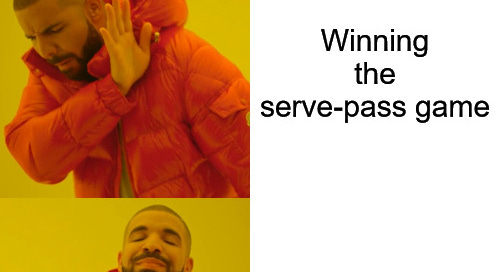January is all about major-competition analysis! I’m applying the Triangle analysis to three recent major competitions in indoor volleyball: the NCAA Women’s National Championshp, the FIVB Women’s World Championship, and the FIVB Men’s World Championship. This week we’re focusing on Terminal Serving and how that was applied in each tournament.
Today we’re looking at the 2022 FIVB Women’s World Championship. Specifically, we’re looking at Terminal Serving in that competition. I’ll add links to each piece of this series as I release them:
NCAA Women: Terminal Serving
NCAA Women: First Ball
NCAA Women: Transition
FIVB Women: First Ball
FIVB Women: Transition
FIVB Men: Terminal Serving
FIVB Men: First Ball
FIVB Men: Transition
How Common Were Terminal Serves?
Terminal Serves were about 16% of points scored in the Women’s World Championship. If we break it down by Triangle phase:
16% Terminal Serves
47% First Ball Points
37% Transition Points
Very similar to the NCAA. A touch more First Ball, a touch more Terminal Serving, a touch less Transition.
The serve-in rate was 89% and about 1-in-20 serves were aces. So servers take a bit more risk in FIVB women’s volleyball than they do in the NCAA, but it’s harder for them to score directly. Add in the fact that the FIVB ball is harder to pass than the NCAA ball and we come to the conclusion that: FIVB passers are better than NCAA passers.
Cool, great conclusion Trinsey.
I’ve been beating this drum a lot lately, but I think it’s just worth reflecting on how hard it is to ace good passers, and that continues to increase as the level gets higher. True, passers also get more accurate, but I think that coaches overrate teaching passing accuracy and underrate the ability to save aces. They are related, but not entirely overlapping skills.
How Did Terminal Serves Effect Winning And Losing?
The average edge of a winning team in Terminal Serving was just +1.2 and the standard deviation was 4.2. The range of Terminal Serving outcomes is a bit smaller than the other two points of the game, which make sense because it’s the smallest area (in terms of total points played) of the game. We’ll see here though that the range in Terminal Serving was smaller in both women’s tournaments (the NCAA and FIVB) compared to the men’s World Championships.
I think here you see the difference between a float serve-dominant game and a spin serve-dominant game. There’s almost no limit to how good a spin server can be- just keep hitting it harder! But there is a limit to how good a float server can be, and many of the best in the women’s game start to approach that level. I don’t want to overstate that fact, but I found it interesting, especially for FIVB middle blockers. Men’s teams probably need to factor serving into their analysis for middles a bit more, while women’s teams might be able to operate more under the assumption that, “we can train her up.”
The team that won Terminal Serving won the match just 55% of the time. Whoa! Pretty shocking result. That’s saying that, in this 2022 Women’s FIVB Championship, that knowing who won the Terminal Serving game told you almost nothing about who won the match. More on this below.
There was only 1 match where a team won only the Terminal Serving game and won the match. Congrats Korea for pulling off that feat that was extremely rare in women’s volleyball this year. In comparison, there were 5 matches that were won by teams that won only the First Ball phase and 8 matches that were won by teams that won only the Transition phase.
How Did Terminal Serves Impact The Top Teams?
Let’s take a look at Terminal Serving by the 4 semi-finalsts: Serbia, Brazil, Italy, and USA:
I love this because it’s a classic tale of 2 styles. Brazil and USA have long been two of the best serving and passing teams in the world. Since Hugh McCutcheon took over the USA team in 2009, USA has basically been somewhere between the best and 3rd-best passing team in the world in every major competition. You see this emphasis on passing in player selection and system. Brazil also has a long (perhaps even longer) track record of being an outstanding serving and passing team.
On the flip side, you have Serbia and Italy playing more of what I think of as a Euro-style game. A little less emphasis on ball control, a little more emphasis on power and risk-taking. Let’s look at how these styles interacted with their ability to prevent opponent sideout.1
So Italy and Serbia, despite serving numbers that didn’t compare well to the Brazilians, still stopped their opponents at a better rate. USA struggled to serve in at times which, despite the ability to pick up aces, harmed their ability to get break points.
Let’s also look at ace prevention:
Keep reading with a 7-day free trial
Subscribe to Smarter Volley by Joe Trinsey to keep reading this post and get 7 days of free access to the full post archives.




